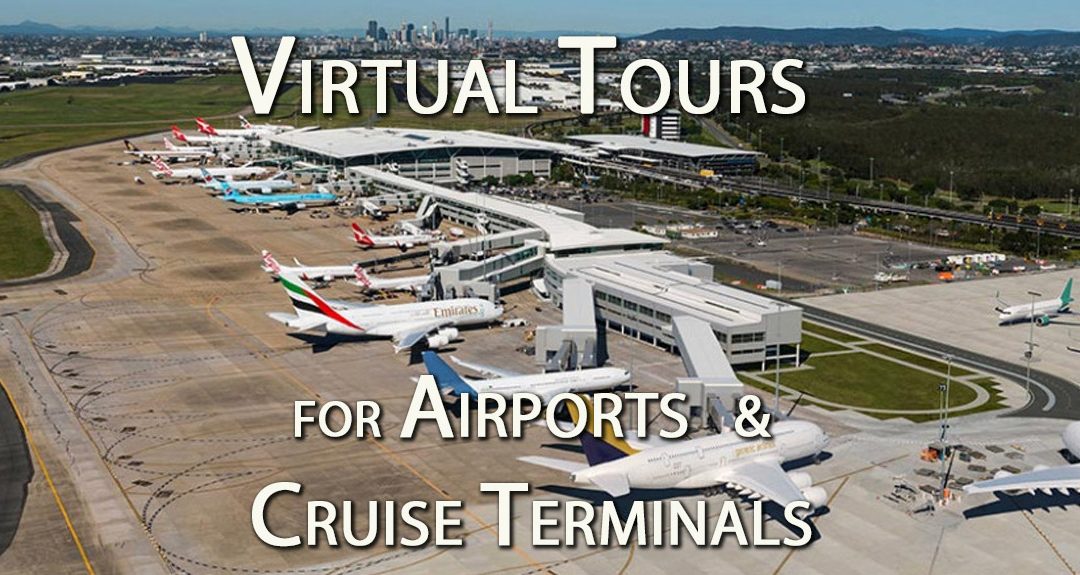For many years Tourism has been one of Australia’s most important Industries, with Travel & Tourism generating billions of dollars for Australia’s economy. Obviously in the last couple of years though, COVID has had a significant impact on the Travel Industry, with local tourism only starting to return to pre-Covid levels in the last few months, and International Tourism just starting to turn around.
Small and Large Tourism Operators have clearly suffered, but the Major Tourism Hubs such as Airports and Cruise Terminals have arguably suffered the most during Covid – and have the most to gain now that tourism is finally picking up.
Now that Local and International Tourists are finally regaining confidence in travel, the major tourism hubs such as Airports and Cruise Terminals are ramping up their promotional and marketing activities to highlight what they have to offer in the post-Covid world.
Virtual Tours to Showcase Tourism Hubs
Along with traditional marketing strategies, Virtual Tours are proving to be one of the most effective ways to showcase the services and facilities available. Virtual Tours offer an immersive and interactive way for visitors to discover what is available and offer a range of benefits that are simply not available via traditional marketing techniques such as Photos or Videos – such as :
- Interaction – rather than passively watching a video.. or simply clicking through a gallery of static photos… a Virtual Tour allows users to be actively involved and control how they interact with council facilities and spaces… This could be navigating through the space, looking around, zooming in on specific objects, or clicking on hotspots to perform an action such as showing a video, linking to a website, filling in a form, or displaying more information
- Innovation – a Virtual Tour provides a memorable “wow” factor that most photos or videos can not
- Connectivity & Accessibility – Provide a spatial awareness which is not possible with most other forms of marketing. Virtual Tours can be used by anyone with internet access via a variety of devices (mobile, desktop, VR Headset)…
- Experiential & Interactive – Offer an “experience” based interface, where users get to Interact and actually participate. This provides a level of emotional attachment not available through traditional media (photos and video)
- Inspirational – Offer a “taste” of the experience and provide insights into what is on offer, which very often results in an “I want to see more” moment.
- Recycle – Virtual Tours are able to incorporate and reference existing content (information, Photos, Video, Stories, Links, Audio, etc…) .
- Extendable – can very easily be updated, modified and improved to update or add extra activities and experiences over time as requirements change
- Display vs Interactive – A Virtual Tour could be presented as a simple display on a Video Wall, but could be switched to Interactive mode for visitors to take controls… For the example below (which is in Display mode), clicking the Full Screen icon will also activate additional functionalilty.
Types of 360° Photos and Virtual Tours
There are many options available with Virtual Tours – from simple 360° Photos to a sophisticated customised Standalone Virtual Tour… here are some examples and options :
Individual 360° Photos (
Click and Drag an image to move around
more than 550,000 views since May 2021

Panospheres can be uploaded directly to Google Maps, Social Media, or 3rd party Tourism sites such as Expedia or Tripadvisor
Standalone Virtual Tours are often one of the most effective ways to promote a business as they give you much more control of the experience. They also offer a wide range of features such as :
- Logo/Branding
- Custom Icons
- Menu Navigation
- External Links
- a variety of Hotspots and popup capabilities (e.g. Photo, Gallery, Video, Audio)
- Auto-rotation
- and much much more.
This type of Virtual Tour can be
- embedded into a website
- run as a standalone presentation
- referenced from Social Media
- sent as a link
- viewed on a Desktop, Mobile DevIce or VR Headset
Here are some examples of Standalone Virtual Tours :
Click and Drag an image to move around
See esplanade.panoview.com.au for Full Screen version
See lescapade.panoview.com.au for Full Screen version
See naturalbridge.panoview.com.au for Full Screen version
Aerial 360°
Aerial 360s offer a unique way to show a large area and, when incorporated into a virtual tour, offer a fantastic framework for showcasing tourist destinations.
Click and Drag an image to move around
25,000+ Views in 10 monthsVirtual Tours published to Google are directly available via Google Search and Google Maps, and can be embedded into a website, social media.. or emailed as a link. However Google Virtual Tours have relatively limited features.
Click and Drag an image to move around
Usually Street View functionality would only be available once the Google Street View car has visited your area… but for new or remote locations this may take years (if at all)… It is however possible to create and publish to Google Maps a Virtual Tour which replicates the Street View experience.
Click and Drag an image to move around
360° Video had developed a bit of a reputation for being poor quality, and complex (and expensive) to produce… however recent technological advances have resulted in dramatic quality improvements and significant cost reductions – making it accessible to even low budget marketing campaigns.
What Does a Virtual Tour Cost?
Prices for 360° Photos or a Virtual Tour start from as little as $120 for an Individual Photosphere (which can be published to Google Maps or embedded into a website) ranging up to several thousand dollars for a large sophisticated and feature rich Standalone Virtual Tour.
Costs will vary depending on the size and layout of the areas you’d like to include in the virtual tour… how you want it to be used,… and the features and functionality you would like to offer. If you’d like to discuss how we can help you create a Virtual Tour for your Tourist Information Centre, give Andy a call on 0403 023 223 or Contact Us.



